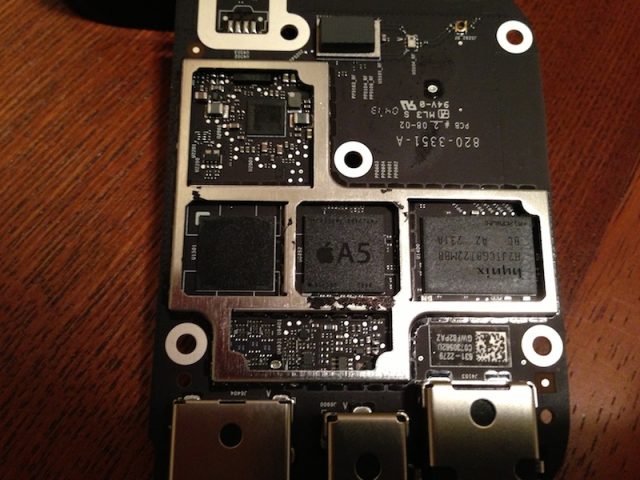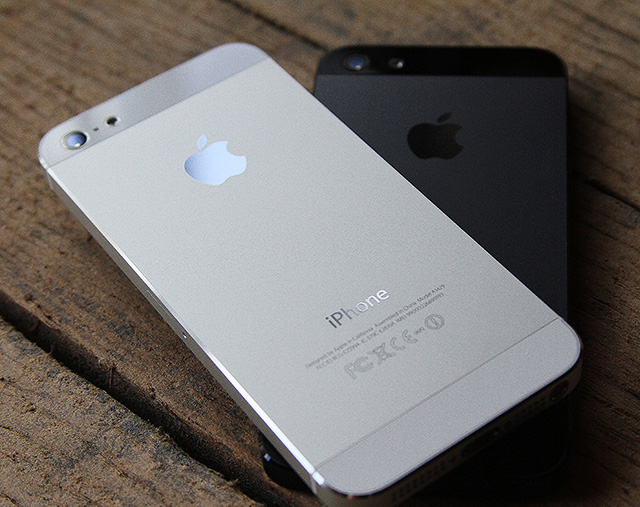Update: There's a reason why you wait for an outfit like Chipworks to dissect a chip before making definite proclamations about it—their teardown of this chip is still in progress, but so far they've discovered that this chip is a redesign of the A5 that is still manufactured on Samsung's 32nm process. A die shot is reportedly forthcoming, at which point we'll know more about just how this chip has changed compared to the existing A5. We'll be following their updates here.
Earlier this year, Apple filed some paperwork with the FCC that pointed to a revised version of the Apple TV. Early speculation suggested a slightly smaller version of the set-top box that used an upgraded Apple A5X system-on-a-chip (SoC), but a rare official comment from Apple on the subject insisted that the tweaked components required new regulatory approval and wouldn't actually change the features of the product.
Now it looks like this tweaked Apple TV is being spotted in the wild, and MacRumors has identified the product's most substantial tweak: a newer, smaller version of the Apple A5 SoC that was originally introduced in the iPad 2 back in 2011. True to Apple's word, this tweaked SoC would have the same features and performance level as the A5 that was introduced in the third-generation Apple TV, but it should consume less power than its predecessor, and it has wide-ranging implications for Apple's future iOS products.
The Apple A5: What a long, strange trip it’s been

Apple has produced more variants of the Apple A5 than it has for any of its other chips so far. The original A5 (model number S5L8940) featured two Cortex A9 CPU cores paired with a dual-core Imagination Technologies PowerVR SGX453MP2 GPU. This chip was manufactured on Samsung's 45nm process and shipped with two CPU clock speeds: roughly 800MHz in the iPhone 4S and roughly 1GHz in the iPad 2.
About a year later, Apple revisited the chip, giving it its first manufacturing process shrink. This new 32nm Apple A5 (model number S5L8942, also manufactured by Samsung) showed up in two products: the third-generation Apple TV (where one of its CPU cores was disabled) and in the tweaked version of the iPad 2 that Apple continues to sell for $399 (this version kept both CPU cores and the 1GHz CPU clock speed of the original). The revised iPad 2, on average, featured 20 to 30 percent better battery life than the version with the 45nm Apple A5, an impressive feat given that all of the other components (including the screen and the battery) remained the same. This version of the A5 also made it into the fifth-generation iPod touch, which features battery life more-or-less similar to the iPhone 4S despite having a smaller battery and a larger screen.
This new A5 (model number S5L8947), then, is the second major revision to the chip. It reportedly measures about 6mm by 6mm, compared to 8.19mm by 8.68mm for the 32nm A5 and 10.09mm by 12.15mm for the original 45nm version. We'll only know for sure who's making this chip and on what manufacturing process when a site like Chipworks gets a clear photo of the die, but one reasonably safe explanation for the size difference is that the new A5 is likely being built on a smaller manufacturing process—a 28nm process would be the most logical option, if only because it's the next smallest process that's currently shipping from any foundry other than Intel's.
This is already kicking off a fresh round of speculation that Apple is finally looking to ditch Samsung for chip production, likely in favor of Taiwan Semiconductor (TSMC), the foundry that also handles manufacturing duties for Qualcomm, Nvidia, and a number of other prominent companies—its 28nm process is mature and is now humming along smoothly after some early hiccups.
This years-old rumor continues to find purchase in part because of the litigious and antagonistic public relationship between Apple and Samsung, but we have yet to see anything from a source I would consider reliable. Without more concrete information, I hesitate to say that Apple is actually moving production to TSMC (especially since Samsung is also ramping up its own 28nm chip production for its Exynos 5 Octa), but it remains a distinct possibility and it could go a long way toward reducing Apple's reliance on one of its chief competitors.
Whoever makes it, the implications are the same
Whatever the manufacturer, it's instructive to look at the path of Apple's 32nm chips to see where the company is going to go with this new manufacturing process (assuming that is in fact what is happening here). First, Apple used it to make a new version of the mature, established Apple A5 for the Apple TV (followed shortly by the iPad 2). This gave Apple and Samsung the chance to iron out any complications in the manufacturing process, and even if something bad had happened (catastrophically low yields, for instance), the stakes for both products are relatively low. Then, over the next few months, 32nm chips with both new and mature architectures rolled out to basically all of Apple's major products: first in the iPhone 5 and the fifth-generation iPod touch, and then to the fourth-generation iPad and the iPad mini.
In all cases, Apple took advantage of the new process to either increase performance in an existing form factor (the A6X in the iPad); offer smaller products with the same performance as previous, larger products (the iPad mini); or both (the iPhone 5 and iPod touch). Assuming that we see the same rollout process for these purported 28nm chips, let's talk through the possibilities for the iOS products that Apple is likely to introduce this year.
The iPhone

Assuming Apple follows its own conventions, we'll be seeing an iPhone 5S in the mid-summer-to-early-autumn timeframe, and a smaller process gives Apple room to increase the phone's performance without sacrificing the phone's battery life or signature thinness (though whether the phone would use a faster version of the current iPhone's A6 or some new, upgraded A7 processor is anyone's guess).
There are also those "low-cost iPhone" rumors that have been hanging around for a couple of years now. We'll only believe that this hypothetical phone is happening when we see it, but a 28nm Apple A5 seems like an ideal way to offer iPhone 4S-level performance in a phone that costs less than the current 4S, both because it can use a smaller battery and because 28nm A5 chips should cost Apple less than 45nm A5 chips do.
The iPad and iPad mini

The full-size iPad is about due for a visual overhaul—its design has been essentially unchanged since the iPad 2 was introduced two years ago, and the Retina versions of the tablet were actually a bit thicker and heavier than the iPad 2. The rumor mill's best information suggests that the iPad Jumbo will be getting an iPad mini-like redesign this year, and a more power-efficient process could help Apple shrink the battery enough to make this possible.
We like the size of the iPad mini, but we're less enamored of its non-Retina display. As in the big iPad, though, putting a Retina display in the smaller iPad will require a commensurate bump in processing power to push all of those pixels. A theoretical 28nm Apple A5X (or A6X), along with more efficient display technology, could allow Apple to fit the innards of a Retina iPad in a future iPad mini's diminutive chassis, the same way the 32nm shrink allowed the company to fit the guts of the iPad 2 in the current iPad mini.
The iPod touch

The fifth-generation iPod touch showed that Apple is no longer committed to refreshing iPod hardware every year anymore, but a 28nm process opens up a couple different possible avenues: either put an A6 in the iPod touch, increasing performance while keeping the battery life constant, or replace the current model's 32nm A5 with a 28nm version, keeping performance constant while increasing the battery life. There's no saying whether either of these will happen (the iPhone 4S was never tweaked to use the 32nm A5, after all), but either is possible if Apple chooses to update the hardware.
A predictable progression
Apple has a way of playing down product specifications in its product announcements, advertisements, and even many of its product pages. But if you pay attention to what actually goes into their devices, the company expends a lot of effort to keep its chips current (if not cutting-edge), though iOS can be so heavily optimized for these chips that Apple doesn't necessarily need to be drawn into the specifications race that we see on the Android side of the fence.
The 32nm process has done well for Apple, but Qualcomm, Nvidia, and others are all currently shipping or planning to ship 28nm chips this year, and the space and power savings this process provides would obviously give Apple some convenient headroom for this year's crop of iOS products, from a heat and power-usage perspective. We'll wait for someone to take this die apart before saying for sure who makes it and what process it's on, but either way a 28nm chip from Apple is the next logical step, and testing it in a relatively low-volume product like the Apple TV first is consistent with the company's past behavior.
Listing image by MacRumors
reader comments
59